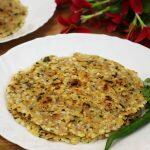Sabudana Thalipeeth Recipe
Sabudana thalipeeth is a popular Maharashtrian dish often made during fasting days (vrat/upvas). It's made with sabudana (tapioca pearls), potato, crushed peanuts, coriander leaves, and flavored with ginger, green chilies and cumin. Here's how to make it easily at home with step-by-step photos and a video recipe.
Servings: 6 thalipeeth
Calories: 250kcal
Equipment
- 1 Medium sized mixing bowl
- 1 skillet or frying pan
Ingredients
- 1 cup medium-sized sabudana tapioca pearls/sago
- ½ cup peanuts unsalted
- 1 big potato or 2 medium size cooked, peeled and grated. (¾ th cup)
- 2 green chilies finely chopped optional
- 1- inch ginger finely chopped
- 1 teaspoon cumin
- salt to taste or sendha namak for fasting
- ¼ cup finely chopped coriander leaves
- 1 teaspoon finely chopped curry leaves, optional
Instructions
- Soaking Sabudana: Rinse the sabudana two or three times until the water runs clear. Drain it, then add one cup of water. Cover and soak the sabudana overnight or 4-6 hours. By morning, all the water should be absorbed. Mash one sabudana to check if it gets mashed easily. Set the soaked sabudana aside.
- Roasting Peanuts: Dry-roast the peanuts in a pan over low to medium heat, stirring constantly until golden brown spots appear. Remove from the heat and let them cool to room temperature. Rub the peanuts between your palms to remove the skin. Coarsely grind the roasted peanuts using a chopper or a mortar and pestle. Tip: Do not grind them too coarsely. They should be finely ground, but not powdered. If there are large chunks of peanuts, it will be difficult to shape or fry the thalipeeth as it will break and not hold its shape.
- Making Sabudana Thalipeeth Dough: In a mixing bowl, add the soaked sabudana, potatoes, chopped peanuts, green chilies, ginger, cumin, salt, coriander leaves and curry leaves. Mix well while mashing them slightly until the mixture holds its shape. Tip: Apply oil on palms before you handle the dough mixture.
- Shaping the Thalipeeth: Lightly oil a piece of parchment paper or butter paper. Take a portion of the sabudana mixture, and place it on the parchment paper or butter paper. Wet your fingers with water and gently pat the mixture to spread it. To prevent the sides from tearing, hold them with your other hand while spreading. Shape the dough into a round disc, similar to a roti (Indian flatbread). Finally, make a small hole in the center. Watch the video for easy understanding.Tip: Using wet fingers prevents the dough from sticking while spreading and shaping thalipeeth.
- An easier way to shape thalipeeth is to use a plate. Place parchment paper on the plate, and spread the dough with wet fingers. This makes it much simpler to rotate and shape the thalipeeth, ensuring they are consistently sized.
- Cooking Sabudana Thalipeeth: Heat a tawa (griddle) over medium-low heat. Once the skillet is hot, place the thalipeeth onto it, with the parchment paper facing upwards. Reduce the heat to low-medium and cook for a minute. Gently peel off the parchment paper. Drizzle one teaspoon of oil over the top and center of the thalipeeth. Cook until golden brown spots appear. Meanwhile you can shape another thalipeeth. Flip and cook the other side until golden and crispy. Remove sabudana thalipeeth to a plate. Serve with chutney or yogurt.Tip: Cook it on low heat until golden brown spots appear, then flip it. Don't flip it too early, or it will break. Also never cook thalipeeth on high heat. Add more oil if needed.
Video
Notes
- Soaking Sabudana: Make sure the soaked sabudana is soft and separate. If it feels hard, sprinkle some water over it and cover and keep it aside for 30 minutes to an hour.
- Binding: Make sure the potatoes are cooked perfectly. Boil potatoes until fork-tender but not mushy. Cool boiled potatoes before grating. Overcooked potatoes may make the thalipeeth mixture soggy and sticky. Also grate the cooked potatoes before adding them to the thalipeeth mixture.
- Cooking: Always cook on medium to low heat for even cooking and crispy edges. High heat will result in soft thalipeeth that are difficult to flip and break easily.
- Flipping carefully: Wait until the bottom side of the thalipeeth is golden brown before flipping to prevent the thalipeeth from breaking.
Nutrition
Calories: 250kcal
